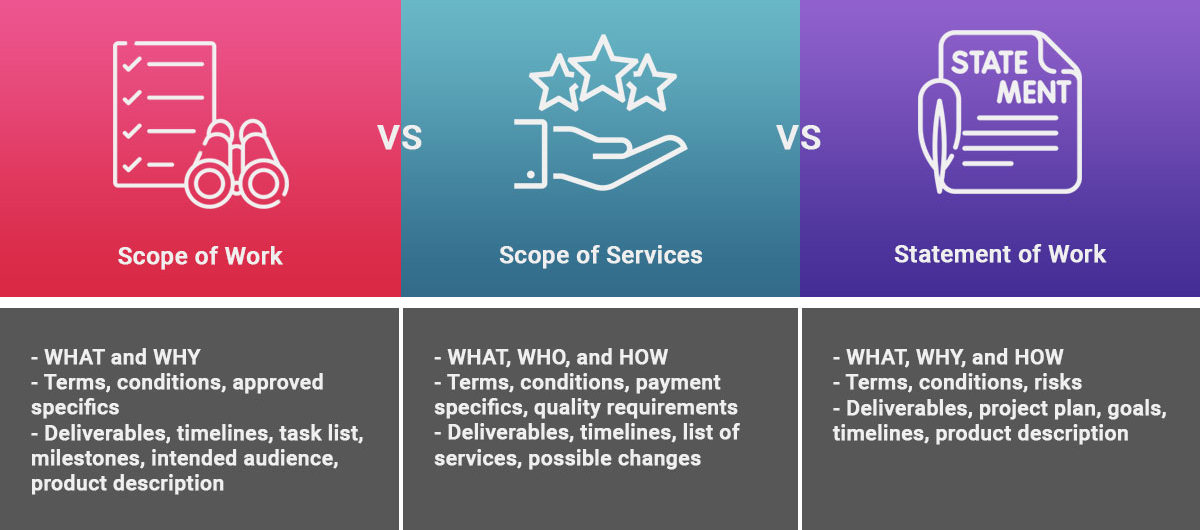Does Your Project Need Scope of Services (SoS) and Is It Different From Other Documentation?
Ensuring that your team follows a firm project plan and has clear communication is vital if you want your business to succeed with the product you have in mind. You need to think through all the related processes and find specialists with relevant skills. In general, managing any project is not an easy procedure. It requires working with extensive paperwork, keeping records, and dealing with legal contracts between clients and vendors.
Thus, to understand the project, the tasks that should be performed during its development and to determine deliverables, project managers and other teammates should have awareness and access to different forms of documentation. So, knowing what Scope of Service (SoS) is and understanding how it is different from Scope of Work (SoW) , Statement of Work (SoW), and other similar documents is what should be done. Therefore, let’s take a closer look at scope of services vs statement of work vs scope of work to help you create a better set of documentation for your project.
Understanding Scope of Services
A scope of services, or SoS, is a document that states which services may be or should be provided by one side of a contract to another. It usually involves major activities required for a project and is created during the discovery phase of the Software Development Life Cycle (SDLC).
For example, if you have a custom software development project in mind that you want to launch and maintain successfully, your agreement may comprise the details of such activities that are included in SDLC, project management process, etc. It is basically a brief overview of WHAT should be done and WHO will be doing the assigned tasks. There is no need to describe subtasks or intricate details, because they may change in the process.
Read Also How Software Development Life Cycle (SDLC) Works and How to Choose a Proper Model
A common way to create a scope of services is to include the following:
- A list that contains the full range of services that are expected from a service provider, including optional services if stated;
- A list with services that won’t be or can’t be offered;
- A tick box system to indicate if services are being provided;
- Conditions when the services may be changed;
- Timelines and quality requirements;
- Payment milestones and terms, including fees and charges.
Of course, the document can contain other details or some of them may be omitted based on each particular case and requirements. Its main goal is to ensure that the team of your company and the vendor you are working with are on the same page and that no one is struggling with a scope creep. And, even when it happens, you can point out the changes in the document to not be afraid of them and be able to face them.
Read Also Running from Avalanche or How You Can Avoid Scope Creep
What Is Confusing About Scope of Service
The main confusion is that this type of agreement can be mixed up with Scope of Work and Statement of Work. Both of them are also known as SoW, therefore, let’s clear out the differences.

Scope of work is a document that guides the team that is working on a project through its details. It states what a project does and doesn’t cover, what it needs and which milestones should be met. All the key features or functionality of an application is mentioned as well. The document also usually includes timelines and deliverables.
Scope of work is mainly about the overall description of a project than about the certain tasks, actions, and responsibilities. It can be a standalone and the only document if both sides agree on it and don’t need scope of services, statement of work, or schedule of works. It is also important to note that some businesses use scope of work and scope of services as interchangeable terms.
Read Also Writing Scope of Work (SoW): Major Steps
As for the statement of work, this document is usually good for products, as it gives exact details of the process from beginning to end. It builds on the scope of work, and it’s more like an external-facing document. Statement of work outlines a project plan, its expected deliverables, and goals. Besides that, it can include the risks involved and the phases of the project. The services to be performed can be limited to a one-time performance.
So, if comparing those agreements with the scope of services, the latter can be used, for example, when you want to have consultation services from a provider. Or, if the focus of the contract is on the “output” and not necessarily the method of performance.
How to write a Scope of Services and what can make the process easier? Let's find out: https://xbsoftware.com/blog/scope-of-services-sos/







